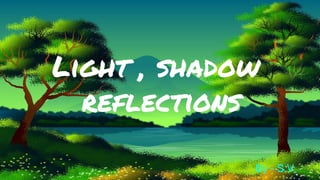
Light , shadow & reflections.
- 1. Light , shadow reflections By - S.V
- 2. Light ● It is a form of energy which gives heat and light energy. ● The objects that emit light on their own are called as luminous objects. Example = Sun ● The objects that don't emit light on their own but reflect light from other objects are known as non-luminous objects. Example = Moon
- 3. Translucent, Transparent and opaque objects ● The objects through which light passes are known as transparent objects. ● The objects through light passes through partially are known as translucent objects. ● The objects through which light does not pass are known as opaque objects.
- 4. SHadow & its characteristics - The region of darkness behind the object where no light is able to reach is known as the shadow of object. - Characteristics of shadow : 1. It is always black, no matter what the colour of the object is. This is because the shadow is formed in the absence of light rays. 2. It gives an idea about the shape of an object. It, however, gives no detail of the object.
- 5. Reflection When the light falls on a surface, it is made to bounce back in the same direction, this phenomenon is known as Reflection of light. There are 2 laws of reflection, They are : -The angle of incidence is equal to the angle of reflection -The incident ray, the normal at the point of incidence, and the reflected ray, all lie in the same plane
- 6. Types of reflection There are 2 types of reflection, They are : 1.Regular reflection 2.Irregular reflection
- 7. Regular Reflection When the light reflects on a well polished surface like mirror, then the light rays are reflected back in a parallel manner, this type of reflection is known as regular reflection.
- 8. IRRegular Reflection When the light reflects on a rough surface like wall, the light rays reflect back in scattered manner, this type of reflection is known as irregular reflection.
- 9. Types of Mirror There are 2 types of mirrors, They are : 1.Concave mirror 2.Convex mirror
- 10. Concave mirror A concave mirror, or converging mirror, has a reflecting surface that is recessed inward.
- 11. Convex mirror A convex mirror is a curved mirror in which the reflective surface bulges towards the light source.
- 12. Types of lenses There are 2 types of lenses, They are : 1.Concave lens 2.Convex lens
- 13. Concave lens Those which feel thinner in the middle than at the edges are concave lenses.
- 14. Convex lens Those lenses which feel thicker in the middle than at the edges are convex lenses.
- 15. Prism divides white light Take a glass prism. Allow a narrow beam of sunlight through a small hole in the window of a dark room to fall on one face of the prism. Let the light coming out of the other face of the prism fall on a white sheet of paper or on a white wall. We see that the prism divides the sunlight into seven different colours.
- 16. Structure of eye We see things only when light coming from them enters our eyes. Eye is one of our most important sense organs. There are various parts of eye, They are : 1.Cornea 4.Retina 2.Iris 5.Lens 3.Pupil 6.Optic nerve
- 17. Cornea The outer coat of the eye is white. It is tough so that it can protect the interior of the eye from accidents. Its transparent front part is called cornea
- 18. Iris Behind the cornea, we find a dark muscular structure called iris. In the iris, there is a small opening called the pupil. The iris is that part of eye which gives it its distinctive colour. The iris also controls the amount of light entering into the eye.
- 19. Pupil The pupil changes size to let light into the eye. It gets smaller in bright light and larger as the amount of light decreases. The size of the pupil is controlled by the iris.
- 20. Retina The lens focuses light on the back of the eye, on a layer called retina . The retina contains several nerve cells.
- 21. Optic nerve Sensations felt by the nerve cells are then transmitted to the brain through the optic nerve.
- 22. Lens The lens is the main part of the eye, the light entering displays on the lens and then forms a image.
- 23. Tips to take care our eyes 1.If advised, use suitable spectacles. 2.Too little or too much light is bad for eyes. Insufficient light causes eyestrain and headaches. Too much light, like that of the Sun, a powerful lamp or a laser torch can injure the retina. 3.Do not look at the Sun or a powerful light directly. 4.Never rub your eyes. If particles of dust go into your eyes, wash your eyes with clean water. If there is no improvement go to a doctor
- 24. Visual Defects Some persons, including children, can be visually impaired. They have very limited vision to see things. Some persons cannot see at all since birth. Some persons may lose their eyesight because of a disease or an injury.
